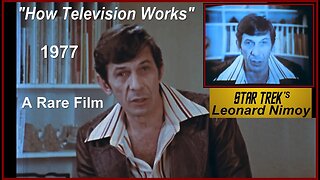WORLD's FIRST PORTABLE TRANSISTOR TELEVISION 1959 (Vintage PHILCO Technology HD)
280821 Like and subscribe. This is an archive, check the link in the end if you are owner. PHILCO introduced the world's First Transistorized Battery Operated Portable TV in 1959. Built so rugged, many still work today. We look at the PHILCO SAFARI portable, both outside and inside. HD images show the internal chassis and CRT with its unique mirror projection system. Run time: 5 mins. -- Philco's Safari was The World’s First battery-powered, portable Transistorized Television. It used 21 transistors, weighed 15 pounds and ran on rechargeable batteries or AC.
The picture was generated by its two-inch CRT picture tube which faced upward inside the set. The image was reflected to a viewing window, which provided a larger viewable image. An adjustable sun visor also made it possible to watch the screen outdoors, even in sunlight.
It came in two models, Black Leather or Natural Tan Leather. It sold for $250, which is about $2,300 today.
COMPETITORS:
The all-transistor SONY TV-8 was made available in the U.S. (1960) less than a year after the Safari was released. This was followed by the SONY Micro-TV in 1962, which proved highly successful.
Both the TV-9 and Micro-TV were “Direct-View” televisions, and did not use a magnifying or projection technique.
Special Thanks to Hagley Museum & Library for PHILCO News articles and photos of the Safari.
http://www.hagley.org
Also, recommended historical sites include:
https://www.radiomuseum.org
https://www.radiolaguy.com/
https://philcoradio.com/
https://www.earlytelevision.org/
Early PHILCO Computers
https://www.youtube.com/watch?v=waca90Fzetk
THE LEGACY OF PHILCO CORPORATION
Philco Corporation was founded in April 1892 in Philadelphia, as the Helios Electric Company.
In 1906, it renamed itself the Philco Battery Company, and became a highly successful pioneer in the production of batteries, radios and televisions.
It created the Surface Barrier Transistor in 1953, a valuable component in the creation of high-speed computers. Philco went on to build the world’s most automated transistor manufacturing plant.
Beginning in 1953, Philco produced a variety of innovative computers for the National Security Agency and the U.S. Navy.
In 1961, Philco was purchased by Ford Motor Company.
In early 1963, Philco was awarded the contract to implement NASA's Mission Control Center at the Manned Spacecraft Center near Houston.
In 1965, Philco-Ford unveiled the sophisticated system that became known as "Mission Control," which played a key role in the Gemini and Apollo space programs, including the historic lunar landings.
Today, the “Philco” brand name is used by a variety of companies around the world.
{Computer History Archives Project}
https://rumblevideoarchive.wordpress.com/
-
 8:16
8:16
Archive of Computer History Archives Project ("CHAP")
7 months agoLeonard Nimoy "'How Television Works" 1977 (fixed) Spock Star Trek TOS remembered
116 -
 2:37:03
2:37:03
The Quartering
6 hours agoLawyer Comments On Nick Rekieta Legal Situation After New Developments
54.7K10 -
 1:30:31
1:30:31
MTNTOUGH Fitness Lab
12 hours agoAKSHAY NANAVATI: Preparing To Ski Across Antarctica For 110 Days ALONE
8.84K -
 54:45
54:45
LFA TV
1 day agoHistorian Propagandists and Joebama are the Real Threat to Democracy | Trumpet Daily 5.28.24 9pm EST
13.9K3 -
 1:00:22
1:00:22
The StoneZONE with Roger Stone
14 hours agoWhy Bud Light Sucks & How Ultra Right Beer Took America By Storm w/ Seth Weathers – The StoneZONE
20.1K4 -
 1:45:37
1:45:37
OFFICIAL Jovan Hutton Pulitzer Rumble
4 hours agoAMA - GIN & TONIC and GREAT CONVERSATION! Bring Your Drink!
18K -
 1:12:58
1:12:58
Redacted News
9 hours ago"World War 3 Begins in just 51 Days!" Western media WARNS it is coming in Mid-Summer! | Redacted
111K553 -
 23:19
23:19
Scammer Payback
10 hours agoWe Created the First Ever 𝗔𝗡𝗧𝗜-𝗦𝗖𝗔𝗠 Call Center
38.3K63 -
 53:29
53:29
Edge of Wonder
8 hours agoReal Frankenstein: Human Head Transplants & Secret Experiments
19.1K7 -
 2:09:43
2:09:43
Quite Frankly
9 hours ago"Human Shield De Niro & The Trump Question" ft Rich Baris 5/28/24
27.4K33